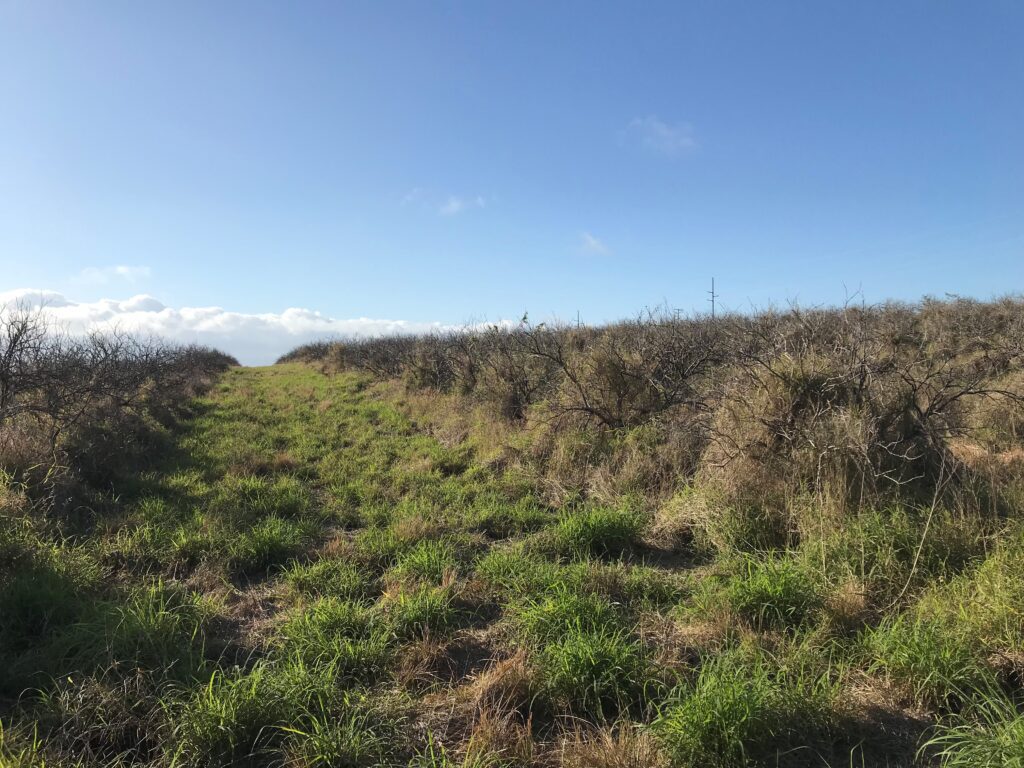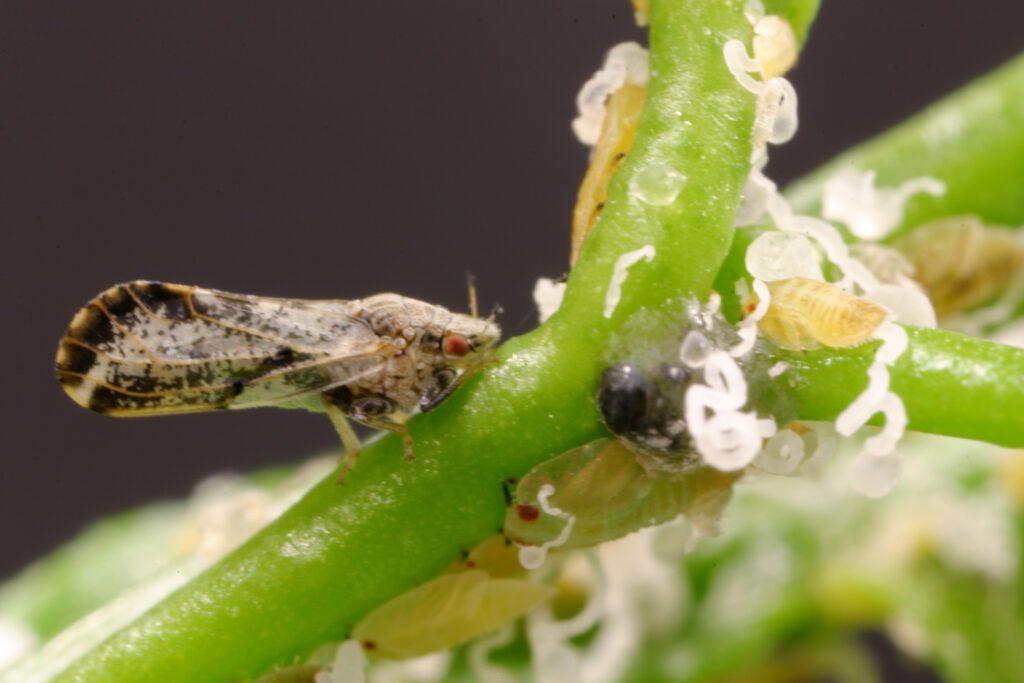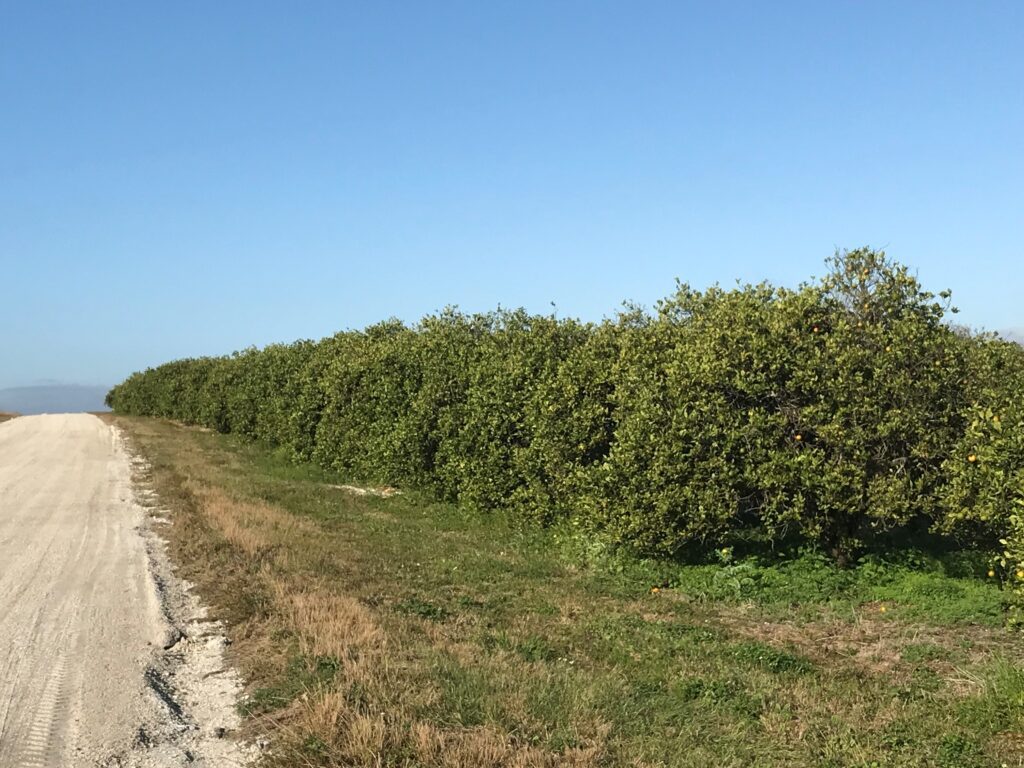(Figure 1) What appears to be a healthy row of trees is most likely infected with HLB but is not showing
signs yet. Keeping trees healthy long-term takes diligent care. Photo by David Austin
Where Has All the Citrus Gone?
Understanding Greening and the Future of Citrus
by DAVID AUSTIN, UF/IFAS Extension Highlands County
It is hard to think of Florida without thinking about citrus. In the past, as you drove down the middle of Florida, you would see giant blankets of green citrus trees growing as far as the eye could see. Northern visitors would pull over to pose with fruit-laden trees, as a reminder of their visit to the Sunshine State. Florida growing conditions were perfect for the world’s finest orange juice. It was the heyday of the citrus industry.


That green skyline is beginning to wane, and more acres of bare ground are showing up where trees once covered the wide-stretching green vista. In other places, sickly thin canopied trees line up like tired soldiers. The remaining healthy groves are becoming fewer. They are mostly corporate groves, with diversified operations, that can afford the care that it takes to keep them healthy. Competition from other countries with cheaper labor has exacerbated the problem. The small farms are becoming a thing of the past.


The Culprit
The core of the problem is a disease called Huanglongbing (HLB). A word that roughly translates to yellow shoots disease. Also known as citrus greening, researchers refer to it as HLB. Researchers at the University of Florida and other institutions are studying the problem from every angle.
The disease is a bacterium with the Latin name Candidatus asiaticus. It attacks the phloem of the plant. Phloem is the pathway that carbohydrates, formed through photosynthesis, travel to feed the tree’s leaves stems, and roots. Without this food, the trees slowly starve and become less productive. Root mass shrinks, and the tree lacks the resources to bring water and nutrients to support its canopy. In the end, the tree will succumb to the disease. To get inside the tree it needs some help.


The Culprit’s Helper
An insect is glad to inoculate the plant with the disease, not realizing it is doing it. This is known as vectoring in the scientific community. The insect vectors the bacteria by feeding on the new growth of infected trees. It then moves the disease around the tree from branch to branch. Because the pathways of the phloem are mostly downward, the insect must infect the tree one branch at a time for it to move around the tree. Over time, the insect spreads the disease to other trees, continuing the infectious cycle.
This tiny insect is called an Asian Citrus Psyllid. It reproduces quickly and moves through groves and neighborhoods. It spots its food source, new citrus growth, by sight. Attracted by the lime green color of the new growth, few trees will escape them. Except for new trees recently acquired from certified citrus nurseries, nearly 99 percent of homeowner citrus trees are thought to likely already be infected.


trees from HLB infection and can increase the longevity of the grove. Photo by David Austin
Making the Best of It
Commercial citrus growers have resorted to spraying often and rotating pesticides, not to control the disease, but to control the citrus psyllids that spread it. Young citrus trees are often treated with a systemic insecticidal drench that is pulled up into the plant through the roots. This type of pesticide only works on smaller trees because it becomes too diluted to reach the outer leaves of larger trees. Because the pesticide is within the plant’s stem, it only targets insects that feed on it. Feeding insects, such as the Asian Citrus psyllids, feed on the plant and quickly die. This reduces the insect’s population and slows down the inevitable spread of the disease. Rotating different pesticides keeps the psyllids from becoming resistant to these pesticides.
Individual plant covers (IPC) are often used on freshly planted trees. The individual covers appear as nets or white bags over the trees. You’ve possibly noticed them looming like ghosts dotted through the local groves. The IPC blocks the psyllid from seeing the new growth, thus they don’t find the trees. These covers are often used along with systemic insecticidal drenches because, even though they keep citrus psyllids from discovering the young trees, other insects will sometimes find their way into the cover. The drench helps control the other insects that sneak in, while the psyllids, not seeing the lime green of the new growth, move on.
Without the IPC, young trees quickly become infected. It doesn’t take long for the whole tree to become infected, especially when it only has a few limbs. Growing under cover until it has developed a significant number of branches gives the tree many more points of growth that the psyllid would need to infect for the whole tree to become infected.
Other growers have opted for using large greenhouses made with the same type of screening as the IPC. These deemed Citrus Under Protected Screens (CUPS), are large enough to protect the trees for many years. These houses are very effective and have eliminated much of the spraying that traditional growers are applying monthly. By saving on spraying, they can help offset the cost of the greenhouses which can be quite high.
Growers have adopted some practices to increase production on each acre they grow. One way is to use closer tree spacing so that they get increased early production. At one time, the recommended citrus spacing for commercial groves was 11 feet between trees and 20 feet between rows. Realizing a tree would not reach as large a size over its lifespan, tree spacing has become closer together. In some groves, trees are so close that equipment has been modified to fit the need for the new spacing.
The Homeowners Dilemma
Spacing is less meaningful to homeowners who face a different challenge to producing fruit in their yards. Homeowners can be more successful by placing IPCs on young trees and upgrading to larger IPCs as trees outgrow the smaller covers. Using systemic pesticides on trees less than 6 feet tall will help control other insects that find their way under the IPC. The pesticide drench that is labeled for homeowner use is Bioadvanced Fruit and Citrus tree and can be purchased at most places that sell insecticides for plants. It contains the active ingredient Imidacloprid. This adds another layer of protection from psyllids and other insects attempting to feed on the tree. Once trees outgrow the IPC, spraying the new growth with organic sprays such as neem oil and spinosad will help keep psyllid populations down.
One of the best ways for homeowners to be successful is to plant HLB-tolerant trees. No citrus are presently known to resist HLB but a few can be infected yet tolerate the disease. Researchers are developing new varieties with different levels of tolerance.
Varieties With Promise for Homeowners
Sugar Belle®, a mandarin hybrid naturally selected for development by the University of Florida is showing great promise for homeowners. It is a sweet fruit with good color that makes it an excellent peel-and-eat variety. It has shown good tolerance to HLB and shares the top of my list of best varieties for homeowners. It has been compared in flavor to the Honeybell tangelo and is considered by some as sweeter in flavor.
US SunDragon is a USDA-developed fruit that is showing great tolerance in Florida. Ripe from November to January, it shows promise as a good choice for juice. It can also be peeled but not as easily as mandarin hybrids. John Gose, who owns a local citrus nursery and previously worked for Lykes Brothers Citrus as their general manager, has positive things to say about US SunDragon.
“SunDragons are showing a high tolerance to HLB while maintaining comparable or better brix to Sugar Belle® and Hamlin,” Gose says. That is very impressive since Hamlin is the standard for early juice oranges in Florida. Brix is a measure of soluble sugar solids that is measured before crops are harvested.
For those of you who like lemons, you’ll be glad to know that most varieties of lemons are tolerant to HLB and have been found to outgrow the disease. Lemons are less cold-tolerant than oranges and should be carefully tended during prolonged Florida freezes.
Many other varieties are in the works with many different rootstock combinations. It will take time to grow these trees and compare how they do over the long run. The process is complicated, but I feel that the combined efforts of researchers will eventually turn the tide. Although the progress has frustrated citrus producers, there is a glimmer of hope that commercial citrus will get a restart in the future.
Though the outlook on the citrus industry is bleak there remain some bright spots. The loss of present grove acreage cannot be color-coated. It doesn’t take an expert to see that healthy groves are becoming the exception instead of the rule. In Lake Placid Florida, where I have spent a good portion of my life, some of the acreage is being replaced with solar panels fields. Somehow, they are not as pleasing as the vistas of the past, and not many travelers are posing with them for photo ops. I guess harvesting energy may be the way of the future. As for me, I look forward to a brighter future for the citrus industry in the Sunshine State.
David Austin is Highlands County’s Residential Horticulture Agent with UF/IFAS. He teaches classes and offers plant advice as well as coordinates Master Gardener Volunteers. He is a lifelong resident of Highlands County. You can reach him at davidaustin@ufl.edu. Email him about upcoming classes such as February’s Homeowner Citrus class. You can also find him on his Facebook page, Hometown Gardener.

